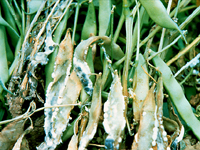By David O. TeBeest
Department of Plant Pathology
University of Arkansas White mold is a serious fungal disease of many plant species, including major crops such as dry beans, canola, chickpeas, lentils, peas, soybeans and sunflowers. It is also a common disease of annual flowers and many vegetables of the home garden such as green beans. White mold typically attacks the flowers and stalks of all the crops and the roots of sunflower as well causing a root rot or wilt. It's a costly disease, causing an estimated loss of $150 million annually. In dry beans, attacks by this fungus cause more than $25 million losses to producers annually. In 1999 outbreaks of this disease caused more than $100 million in losses in Nebraska, North Dakota and Minnesota alone.
Controlling white mold can be very difficult because the fungus (Sclerotinia sclerotiorum) infects a wide variety of plants and produces sclerotia (hard black structures similar to mouse or rat droppings) that can survive harsh conditions for years. There is very little genetic resistance to this disease in the important commercial crop cultivars.
Scientists in the United States Department of Agriculture Agricultural Research Service (USDA-ARS) and ten universities are addressing problem using integrated approaches to management of white mold on three fronts: by studying the disease cycle and spread, by developing germplasms with resistance to the disease, and by testing chemical, cultural and biological agents to control this disease. The task force is called the National Sclerotinia Initiative which was budgeted $960,000 to support 20 different projects aimed at minimizing the disease. For more information go to http://www.ars.usda.gov/is/pr/2003/030311.htm
.
 |
Views: White mold is an important disease of many plants caused by the fungus, Sclerotinia sclerotiorum. In 1999, this disease alone caused more than $100 million in losses on sunflower in Nebraska, North Dakota and Minnesota.
Click image for an enlarged view and more information. |
